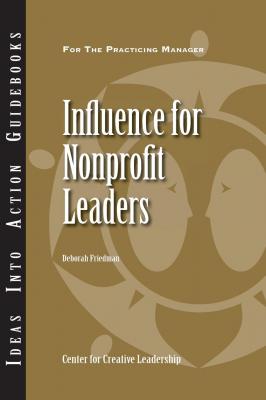Influence for Nonprofit Leaders. Deborah Friedman
Чтение книги онлайн.
Читать онлайн книгу Influence for Nonprofit Leaders - Deborah Friedman страница

AN IDEAS INTO ACTION GUIDEBOOK
Influence for Nonprofit Leaders
IDEAS INTO ACTION GUIDEBOOKS
Aimed at managers and executives who are concerned with their own and others’ development, each guidebook in this series gives specific advice on how to complete a developmental task or solve a leadership problem.
| LEAD CONTRIBUTOR | Deborah Friedman |
| CONTRIBUTORS | Gloria Bernabeu |
| Shera Clark | |
| Karen Dyer | |
| Lynn Fick-Cooper | |
| Kelly M. Hannum | |
| Lyndon Rego | |
| Harold Scharlatt | |
| Bertrand Sereno | |
| Sandrine Tunezerwe | |
| DIRECTOR OF ASSESSMENTS, TOOLS, AND PUBLICATIONS | Sylvester Taylor |
| MANAGER, PUBLICATION DEVELOPMENT | Peter Scisco |
| EDITORS | Stephen Rush, Karen Lewis |
| ASSOCIATE EDITOR | Shaun Martin |
| ASSISTANT EDITOR | Joan Bello |
| DESIGN AND LAYOUT | Joanne Ferguson |
| COVER DESIGN | Laura J. Gibson |
| Chris Wilson, 29 & Company | |
| RIGHTS AND PERMISSIONS | Kelly Lombardino |
Copyright © 2013 Center for Creative Leadership.
All Rights Reserved. No part of this publication may be reproduced, stored in a retrieval system, or transmitted, in any form or by any means, electronic, mechanical, photocopying, recording, or otherwise, without the prior written permission of the publisher. Printed in the United States of America.
CCL No. 459
ISBN No. 978-1-60491-170-1
CENTER FOR CREATIVE LEADERSHIP
AN IDEAS INTO ACTION GUIDEBOOK
Influence for Nonprofit Leaders
Deborah Friedman
THE IDEAS INTO ACTION GUIDEBOOK SERIES
This series of guidebooks draws on the practical knowledge that the Center for Creative Leadership (CCL) has generated since its inception in 1970. The purpose of the series is to provide leaders with specific advice on how to complete a developmental task or solve a leadership challenge. In doing that, the series carries out CCL’s mission to advance the understanding, practice, and development of leadership for the benefit of society worldwide.
CCL’s unique position as a research and education organization supports a community of accomplished scholars and educators in a community of shared knowledge. CCL’s knowledge community holds certain principles in common, and its members work together to understand and generate practical responses to the ever-changing circumstances of leadership and organizational challenges.
In its interactions with a richly varied client population, in its research into the effect of leadership on organizational performance and sustainability, and in its deep insight into the workings of organizations, CCL creates new, sound ideas that leaders all over the world put into action every day. We believe you will find the Ideas Into Action Guidebooks an important addition to your leadership toolkit.
Table of Contents
Conducting an Influence Session
IN BRIEF
For a leader, having the ability to influence others is important. In nonprofit organizations leaders must successfully manage employees and volunteers, and maintain their commitment to the organizational mission. Leaders must also influence stakeholders, such as foundations, donors, and government agencies, which have control over the nonprofit’s funding.
To successfully influence these various groups, you need to be aware of three influence outcomes: resistance, compliance, and commitment, with commitment being the most desired outcome. You also need to be aware of the various stakeholder groups for your organization, and how to adjust your influence tactics according to your audience. Finally, you need to learn how to use a variety of influence tactics, such as rational persuasion, consultation, inspirational appeals, and collaboration.
Next, you should complete a self-assessment of your current influence skills, and determine what areas you are strong in and what areas you need to develop. Then you can plan an influence session, where you determine what tactics you would use for a given audience, and put those tactics into place. Through self-awareness, skill building, planning, and successful execution, you can utilize influence as a means of achieving your nonprofit’s goals.
Why Influence?
Influence is the power and ability to personally affect others’ actions, decisions, opinions, or thoughts. As such, influence is an essential component of leadership, allowing leaders to promote ideas and to inspire people. Influence is important because it helps leaders achieve desirable outcomes, such as communicating a vision, aligning the efforts of others, building commitment to the mission and work, and expanding an organization’s or a community’s capacity to meet its challenges. Many leaders have influence in their organizations, but they are not always sure how best to use it.
In nonprofit organizations, influence is particularly important. Relationships are vital to a nonprofit’s success. Leaders often use their influence to achieve results through staff members, volunteers, and other stakeholders. Nonprofit leaders don’t always have the same tools as leaders in corporate enterprises, such as the resources to grant promotions or to reward teams and individuals with bonuses. Nonprofit staff and volunteers often consider their work not just a job but a passion and a commitment. The influence a leader practices can keep people motivated. If volunteers and staff lose faith in the nonprofit’s mission and its leadership, they may not want to donate their time and energy to that cause and may seek opportunities elsewhere.
Influence in a nonprofit organization also helps to bring in and maintain funding to continue the nonprofit’s work. Nonprofits are often dependent on various sources for funding. Leaders in